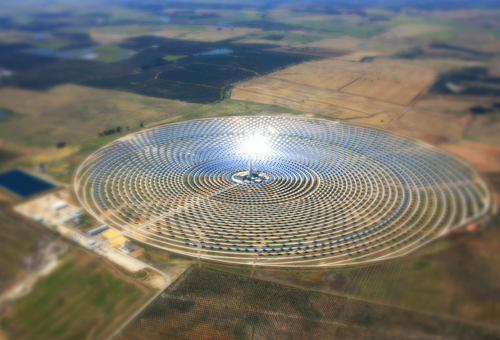
Solar power is a great idea, but it is no good at night or when the sun does not shine – right? Wrong! In southern Spain there's now a solar power plant that can run constantly. We are used to seeing solar panels on houses and in solar arrays. These work by converting sunlight directly into electricity using photoelectric cells, but Torresol Energy was formed to introduce and test new technologies that make concentrated solar energy an economically competitive option and a real, viable, ecological and sustainable alternative to traditional energy sources. Conserving the environment for future generations is one of Torresol Energy's main commitments.
Gemasolar is an innovative 19.9 MW CSP plant, the first commercial experience in the world using molten salt thermal storage in a central tower configuration. The plant is located in Fuentes de Andalucía, Seville, and started commercial operations in May 2011. The plant consists of a 140 metre high solar power tower that derives its energy from an array of 2,650 heliostats, or mirrors circled around it, reflecting the sun’s rays onto the molten salt core.
Spain has acquired global technology leadership in the field of solar energy over the last few decades. The work of SENER, which owns 60 percent of Torresol Energy, started in the 1980s. The firm focused on finding technology for large scale cost-efficient innovations for power generation, and by 2005 it was ready to undertake the design, manufacturing, installation, testing and validation of a CSP receiver prototype in collaboration with the government research and innovation organisation CIEMAT. At the same time it worked on the design of the 120 square metre heliostats, their orientation mechanism (the heliostats track in two axes – each has two motors with a built in controller that recalculates and readjusts the position every four seconds using SENSOL software) and the molten salt storage system.
Two years later with the technology thoroughly tested SENER decided to proceed with Gemasolar. The Torresol Energy JV with Masdar was formed, and construction started the following year. The plant has been operational since May 2011. Its first year of operation exceeded all expectations. It supplied more than 100 GWh of power provided to the grid.
So what are the advantages of this unique plant, the first CSP unit in the world to include a molten salt thermal storage system? “Apart from opening the way to a new generation of solar power technology,” says Álvaro Lorente, General Manager of Torresol Energy. “The most obvious advantage is that it supplies continuous power in a flexible way. That is to say, the turbine can operate without stopping overnight or if there is a cloud. That prolongs the life of the turbine, and in addition we can manage its output according to demand according to peaks and troughs.”
There are a host of other advantages, he enthuses. “Its very simplicity makes it a low risk operation. The fluid is concentrated in a small area, reducing thermal loss and keeping maintenance costs low, and the same fluid is used for both heat transfer and storage, resulting in less thermal exchange. Additionally the molten salts reach extremely high temperatures, which maximises thermodynamic efficiency.” Gemasolar’s 19.9 MW turbine is a strategically capable installation, he says, able to supply electricity to 27,500 households. “Eventually the plant will be able to supply 24 hours of uninterrupted production per day on most summer days, providing a higher annual capacity factor than most baseload plants such as nuclear power plants. In this way, the reliability of solar energy becomes comparable to that of conventional fossil-fuel power plants, a decisive factor as the demand for renewable energy increases.”
However another vital element for the Torresol partners is the amount of local input they have been able to achieve, says Lorente. “Since the company was created in 2008 we’ve had a solid commitment to creating a network of local and national suppliers in order to generate wealth around the facilities. In all the installations we have done we have boosted local employment, with about 80 percent of supplies and 70 percent of the talent coming from local sources.” As befits an alternative energy enterprise, both Gemasolar and Torresol O&M were recently awarded ISO 14001 certification for environmental management and OHSAS 18001 certification for workplace health and safety.
Masdar is keen to be able to bring these principles as well as the technologies to the Middle East. North Africa has plenty of sun, so has Chile for example. However with the former being a desert and the latter subject to earthquakes, the technology will need to be refined to suit local conditions. Torresol Energy is studying weather conditions and working with a number of governments and entities around the world to increase its understanding of how local content, local talent and local supply chains can be optimised to bring the benefits of solar power where it is most needed.
Solar thermal technology is a relatively new industry, hungry for investment at this early stage of development, says Álvaro Lorente, but with the ability to cut unit costs to a fraction of current levels as it supplants fossil fuels. Cost reduction can be achieved using different ‘levers’, he explains. “We can utilise R&D to gain economies of scale, for example constructing larger plants and developing the specific learning curve from each solar thermal technology. As the industry matures a supplier base will grow up and standardisation of components will cut costs further. At Torresol Energy we have a solar development programme: a number of central complexes will be built simultaneously with the twin objectives of creating a supplier industry and improving plant efficiency.”
Really, research is the key. Torresol Energy’s current projects include; cloud location in collaboration with the University of Almeria; prediction of solar radiation in partnership with the Spanish Centre for Renewable Energies CENER; product development to improve reflectivity levels on the heliostat field, with Tekniker; and software optimisation to improve plant efficiency. A parabolic trough plant operation simulator will help training of operators on sites that use that technology, while mathematical models are being developed to accurately predict wind conditions. All these share the twin objectives of production growth and cost reduction in operation and maintenance.
Written by John O'Hanlon, research by Louisa Adcock
DOWNLOAD
 Torresol-Euro.Energy-Apr13-Bro-s.pdf
Torresol-Euro.Energy-Apr13-Bro-s.pdf













